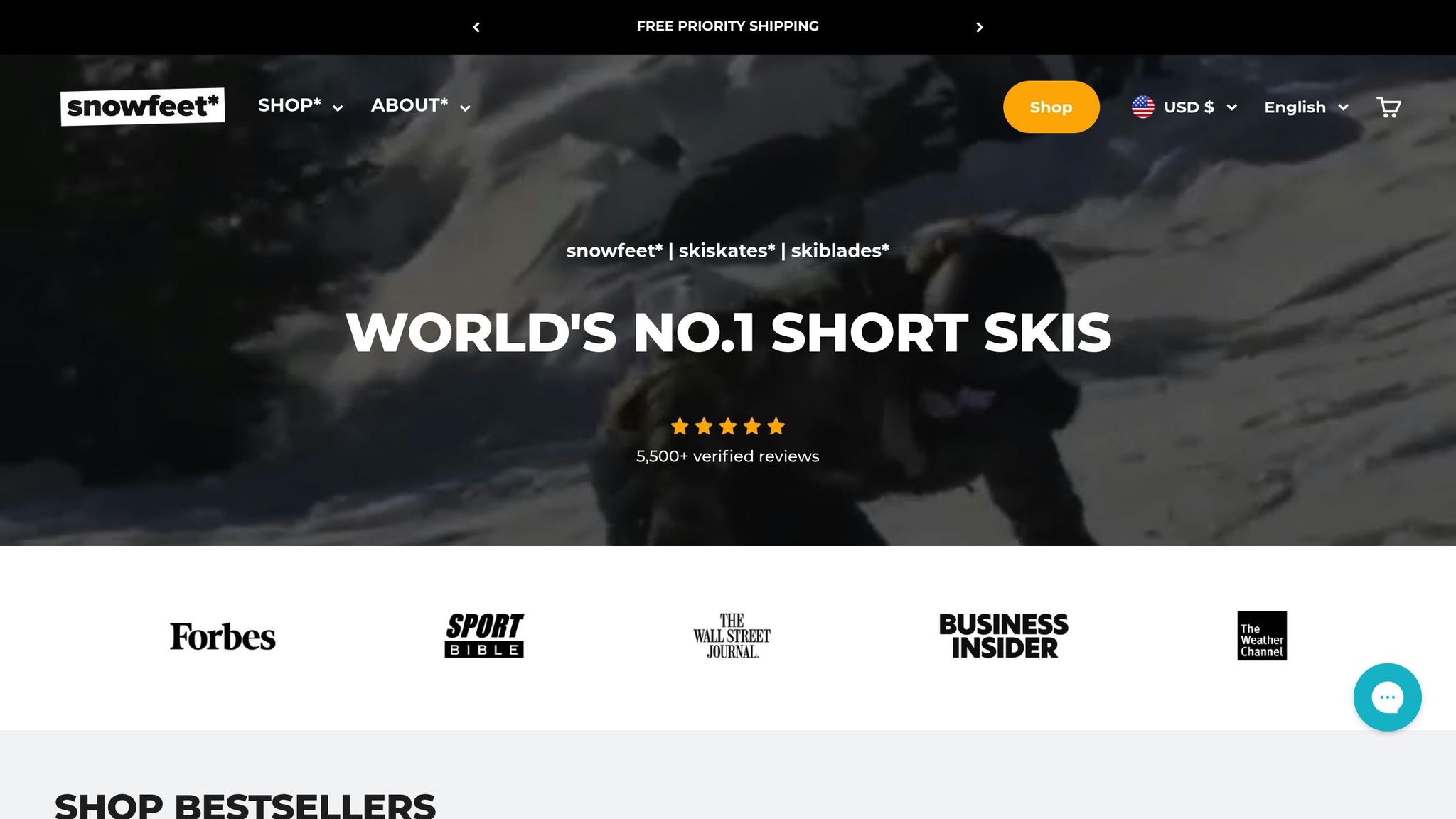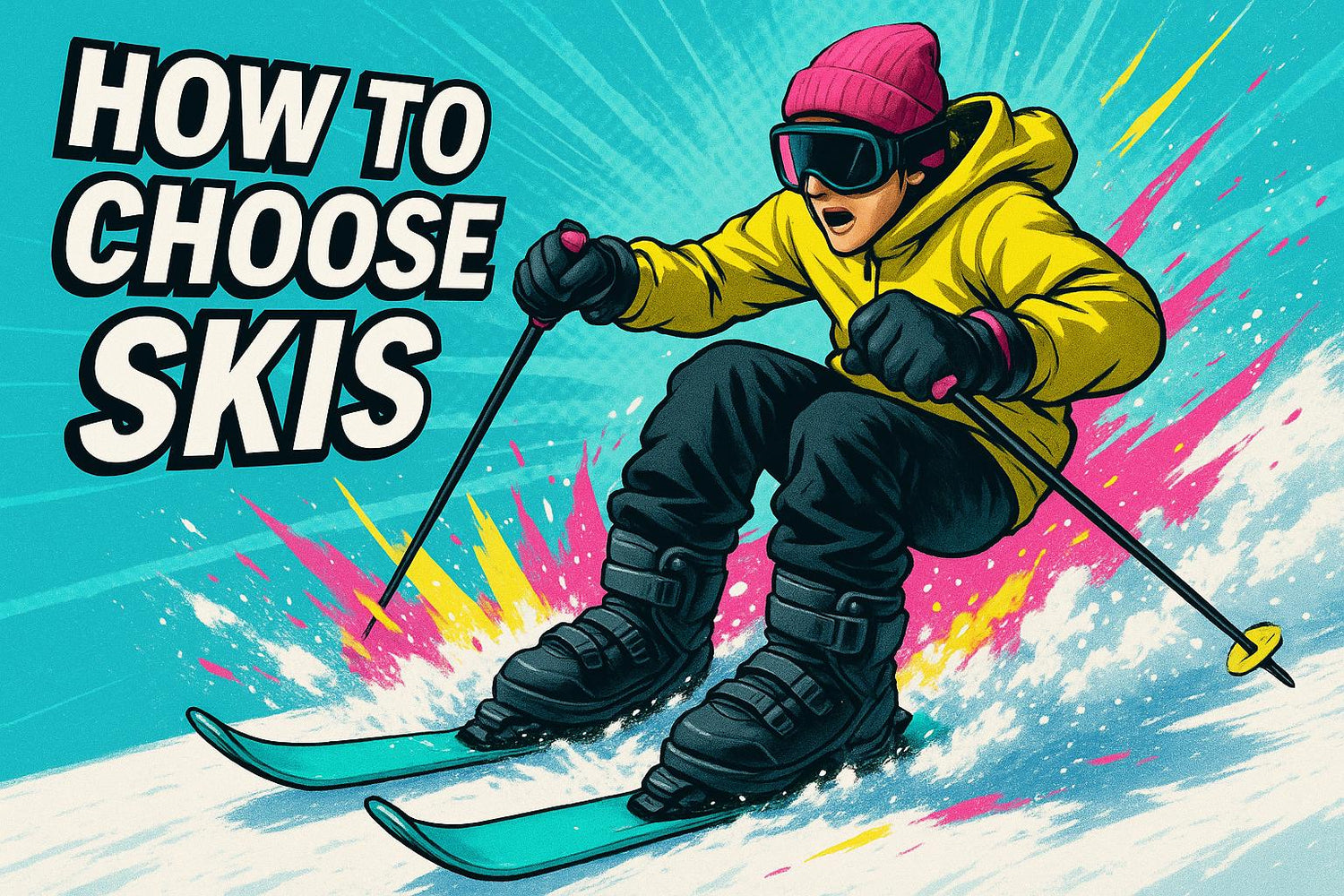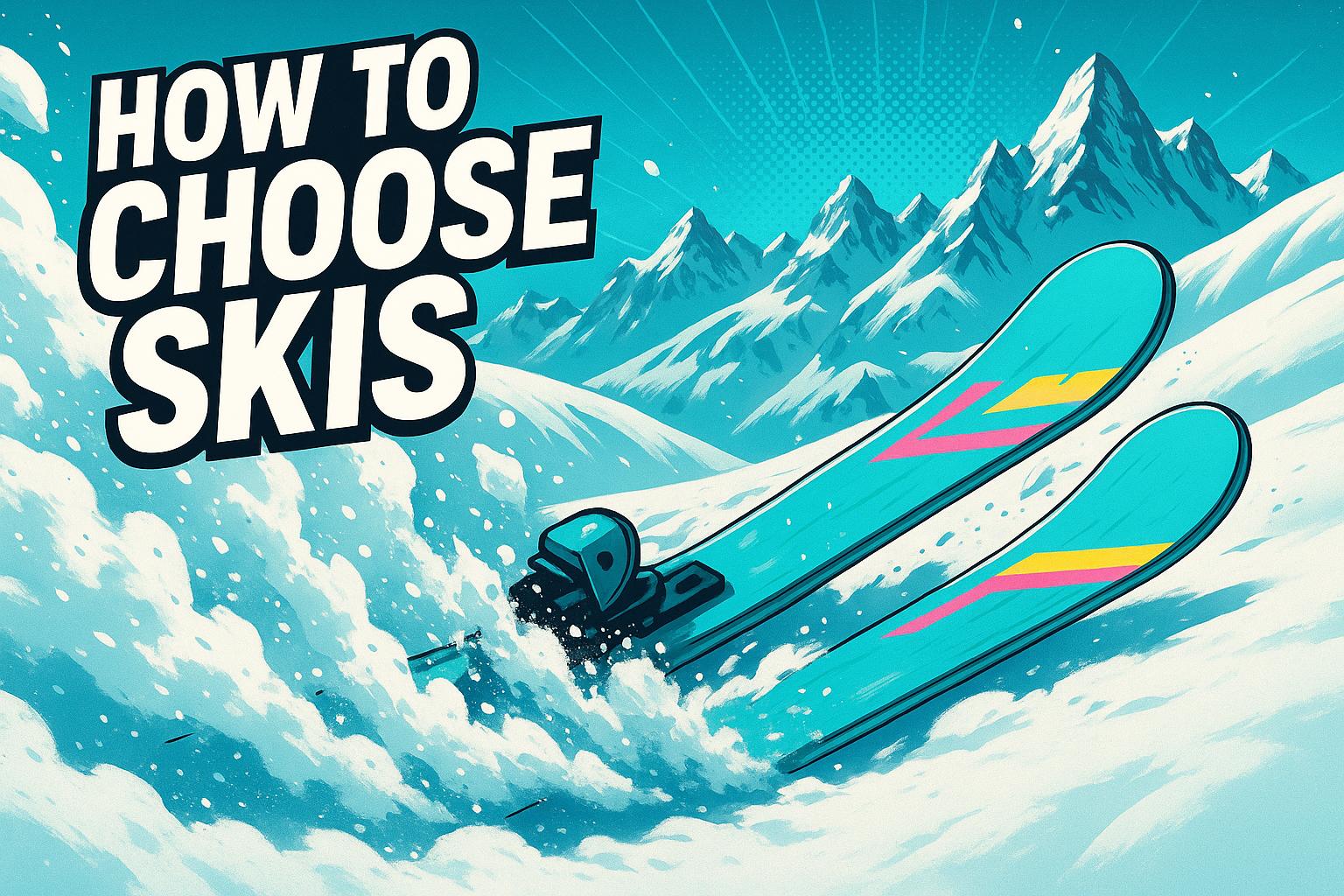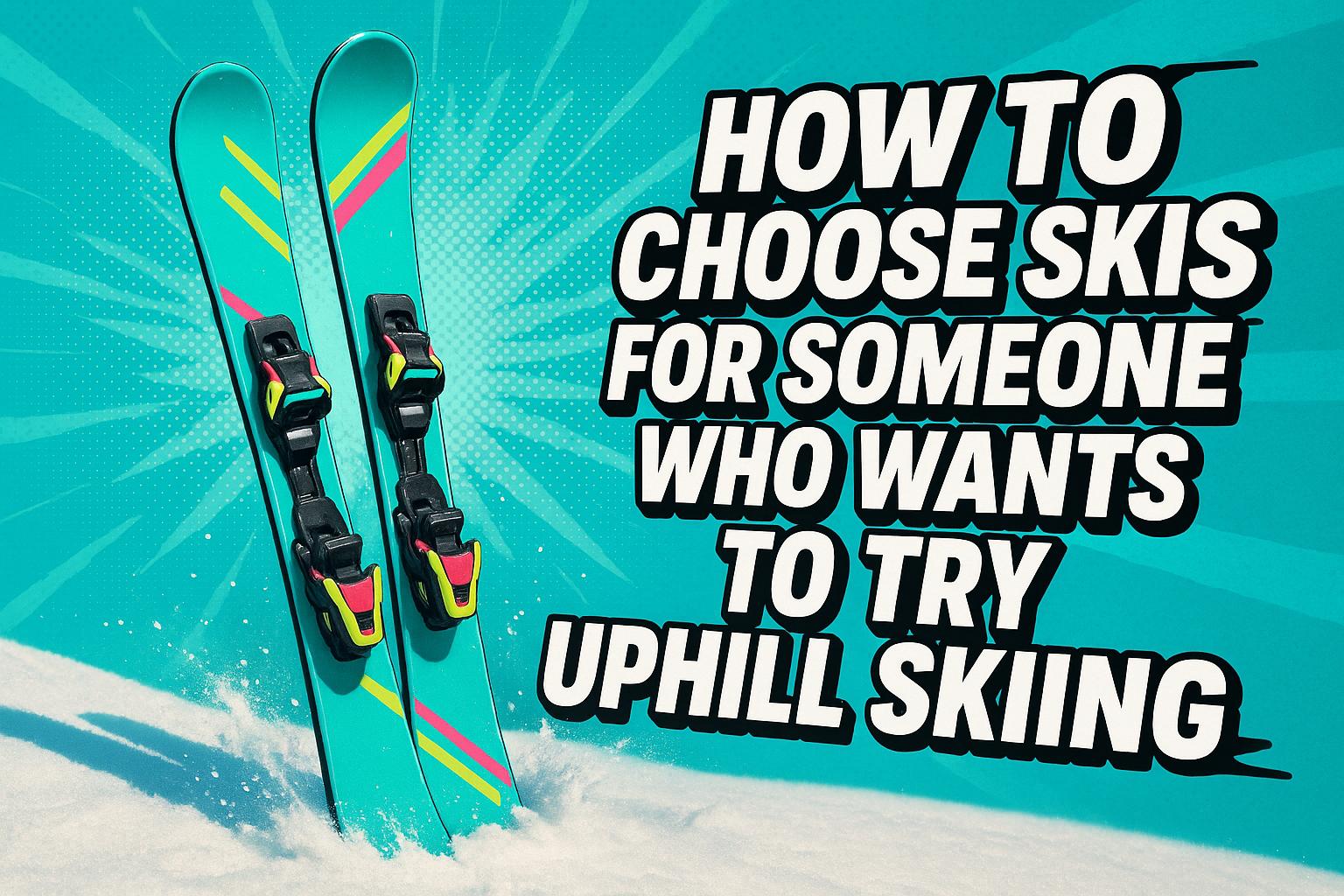Passare dallo snowboard allo sci? Ecco il punto: l'attrezzatura giusta fa tutta la differenza. Sci più corti, come gli Skiblades e gli Skiskates di Snowfeet, sono perfetti per gli snowboarder che imparano a sciare. Perché? Sono più facili da controllare, funzionano con gli scarponi da snowboard (quindi niente scarponi da sci rigidi!) e risultano familiari. Inoltre, sono compatti, leggeri e convenienti, a partire da 150$.
Ecco cosa devi sapere:
- Perché sci più corti? Curve più facili, meno cadute e più fiducia.
- Scarponi da snowboard? Sì! Gli sci Snowfeet sono compatibili, quindi niente scarponi nuovi costosi.
- Opzioni: Scegli tra Skiskates da 44 cm per un'atmosfera da pattinaggio o Skiblades da 120 cm per più velocità.
- Budget: I prezzi variano da 150 a 690 $ - conveniente rispetto ai set completi da sci.
L'attrezzatura Snowfeet è una svolta per gli snowboarder che vogliono provare lo sci senza il fastidio degli sci e scarponi tradizionali. Pronto a scendere sulle piste? Immergiamoci!
5 motivi per cui sto PASSANDO dallo snowboard allo sci questa stagione
Principali differenze tra snowboard e sci
Passare dallo snowboard allo sci non significa solo indossare un set diverso di attrezzatura. Significa imparare modi completamente nuovi di muoversi, bilanciarsi e controllare la discesa sulla montagna.
Come cambiano movimento e tecnica
Lo sci ti mette in una posizione frontale con ogni gamba che si muove indipendentemente, un grande cambiamento rispetto alla postura laterale e al movimento unificato del corpo nello snowboard. Nello snowboard, le curve sono guidate inclinando tutto il corpo, mentre nello sci si fa affidamento su un edging preciso e tecniche come la "pizza" (cuneo) per sterzare e controllare la velocità.
Terreno pianeggiante? Qui gli sciatori hanno il vantaggio. Mentre gli snowboarder spesso devono slacciare e spingersi avanti, gli sciatori possono pattinare facilmente in avanti, usando i bastoncini per un'ulteriore spinta. Questo rende molto più fluido muoversi sulla montagna per gli sciatori.
Adattarsi a queste tecniche è una cosa, ma il comfort gioca un ruolo enorme nel rendere la transizione più facile - specialmente quando si tratta di scarponi.
Comfort dell'attrezzatura e compatibilità degli scarponi
Parliamo di scarponi. Gli snowboarder sono abituati al comfort e alla flessibilità, ed è qui che entrano in gioco i prodotti Snowfeet*, offrendo compatibilità con i tuoi scarponi da snowboard esistenti per una transizione più fluida.
Gli scarponi da sci tradizionali, come quelli di marchi come Rossignol, Atomic e Head, sono un'altra storia. Sono rigidi, più pesanti e utilizzano sistemi a fibbia per fornire supporto laterale. Al contrario, gli scarponi da snowboard sono più leggeri, più flessibili e spesso presentano lacci o sistemi BOA per la chiusura.
Ecco una rapida panoramica:
| Caratteristica dello scarpone | Scarponi da snowboard | Scarponi da sci tradizionali |
|---|---|---|
| Comfort | Flessibile e più confortevole | Rigido e meno confortevole |
| Peso | Generalmente più leggero | Più pesante |
| Sistema di chiusura | Lacci o sistemi BOA | Fibbia |
| Flessibilità | Flessibilità più morbida | Più rigido per il supporto laterale |
| Camminare | Più facile camminare | Più difficile camminare |
Qui entrano in gioco gli Skiblades e gli Skiskates Snowfeet*. Sono progettati per funzionare con i tuoi scarponi da snowboard, permettendoti di mantenere il comfort e la flessibilità a cui sei abituato mentre provi lo sci. Questo significa meno tempo ad adattarti a scarponi rigidi e poco familiari e più tempo per concentrarti a padroneggiare le nuove tecniche.
Se decidi di provare gli scarponi da sci tradizionali, preparati a una curva di apprendimento. Devono calzare aderenti, con le dita che sfiorano appena la punta e il tallone ben saldo quando ti pieghi in avanti. Le fodere si ammorbidiranno e si modelleranno ai tuoi piedi col tempo, ma inizialmente potrebbero sembrare restrittive rispetto alla libertà offerta dagli scarponi da snowboard.
Perché gli Sci Corti come Snowfeet* funzionano meglio per gli snowboarder

Passare dallo snowboard allo sci non significa dover lottare con sci lunghi e ingombranti. Gli sci corti - come quelli di Snowfeet* - offrono agli snowboarder un modo per mantenere quella sensazione agile e giocosa a cui sono abituati sulle piste.
Il vantaggio chiave? Manovrabilità. Gli sci corti permettono curve rapide e decise con facilità e sono perfetti per navigare spazi stretti - movimenti che per gli snowboarder sono naturali. D'altra parte, gli sci lunghi tradizionali sono progettati per curve ampie e ampie, che possono risultare goffe e poco familiari per i principianti. Scopriamo perché Snowfeet* si distingue rispetto ai marchi di sci tradizionali.
Come Snowfeet* si confronta con i marchi tradizionali di sci
I prodotti Snowfeet* sono progettati con semplicità e versatilità in mente, rendendoli una scelta eccellente per gli snowboarder che provano lo sci per la prima volta. Ecco un rapido confronto:
| Caratteristica | Snowfeet* Skiblades/Skiskates | Sci tradizionali (Rossignol, Atomic, Head) |
|---|---|---|
| Gamma di lunghezze | 44–120 cm | 150–200+ cm |
| Portabilità | Compatto, entra in uno zaino (~9 libbre) | Ingombrante, richiede portapacchi o borsa grande |
| Compatibilità degli scarponi | Scarponi standard da sci/snowboard | Richiede scarponi da sci specializzati |
| Curva di apprendimento | Facile, adatto ai principianti | Più ripide, spesso richiedono lezioni |
| Terreno | Parchi, sentieri, versatili | Piste battute, powder, discese ad alta velocità |
Una caratteristica distintiva di Snowfeet* è la loro portabilità. Con circa 9 libbre e abbastanza piccoli da entrare in uno zaino, sono facili da trasportare ovunque - che tu li stia mettendo in macchina o salendo sui mezzi pubblici. Confrontali con gli sci tradizionali, che richiedono attrezzature extra come portapacchi o borse oversize per il trasporto.
Gli sci tradizionali sono spesso pensati per sciatori esperti che vogliono fare curve lunghe ad alta velocità o galleggiare nella neve fresca. Ma se sei uno snowboarder che inizia a sciare, probabilmente preferirai qualcosa che sia familiare e divertente - come Snowfeet*.
Agilità e Flessibilità dei prodotti Snowfeet*
Oltre alla portabilità e facilità d'uso, i prodotti Snowfeet* brillano per agilità. La loro lunghezza ridotta rende naturali movimenti rapidi e precisi e arresti improvvisi, un grande vantaggio per gli snowboarder che passano agli sci. Sono meno intimidatori degli sci lunghi, offrendo migliore controllo e stabilità fin dall'inizio. Molti snowboarder riferiscono di sentirsi sicuri sugli sci corti in poche ore, grazie al rischio ridotto di agganciarsi o incrociare gli sci.
Snowfeet* combina anche elementi di pattinaggio e sci, sfruttando i movimenti laterali e il controllo del bordo che gli snowboarder già conoscono. E se ti piacciono i trick o il freestyle, questi sci corti sono perfetti per gli snowpark. Con attacchi regolabili, sono facili da condividere con gli amici e abbastanza versatili per piste battute, sentieri escursionistici e altro.
sbb-itb-17ade95
Come scegliere il modello Snowfeet* giusto
Ora che abbiamo esaminato i vantaggi di Snowfeet*, scopriamo quale modello è il tuo abbinamento perfetto. Scegliere quello giusto dipende dal tuo livello di abilità, dal tipo di terreno che preferisci e dal tipo di esperienza sciistica che cerchi.
Opzioni Modello Snowfeet*
Snowfeet* offre quattro modelli principali, ciascuno con un design compatto e agile che soddisfa diverse esigenze. Ecco una rapida panoramica:
- Skiblades da 65 cm: Ottimi per principianti. Queste lame più corte facilitano l'apprendimento e la padronanza delle basi.
- Skiblades da 99 cm: Un solido compromesso. Offrono più stabilità rispetto alla versione da 65 cm, rendendoli ideali per un mix di terreni e un po' più di velocità.
- Skiblades da 120 cm: Progettati per gli amanti del brivido. Questi sono più simili agli sci tradizionali, offrendo più velocità e stabilità per rider esperti che affrontano pendii ripidi.
- Skiskates da 44 cm: Un ibrido tra sci e pattinaggio. Perfetti per chi ama l'idea di scivolare sulla neve come se stesse facendo rollerblade o giocando a hockey su ghiaccio.
"Skiskates è il miglior prodotto per le piste che abbiamo sviluppato finora. Adoro quanto siano facili da sciare e pattinare e quanti tipi diversi di trick posso eseguire senza molto sforzo e quasi nessuna restrizione."
I Skiskates sono particolarmente popolari tra i rider esperti. La loro costruzione con anima in legno, simile agli sci tradizionali, garantisce durata e reattività, rendendoli precisi e veloci.
Confronto Modelli Snowfeet*
Per facilitare la tua decisione, ecco un confronto affiancato dei diversi modelli:
| Modello | Lunghezza | Ideale per | Terreno | Livello di abilità | Prezzo |
|---|---|---|---|---|---|
| Skiskates | 44 cm | Skating, acrobazie | Piste battute, parchi | Intermedio/Pro | Da $390 |
| Skiblades | 65 cm | Imparare le basi | Parchi, piste facili | Principiante/Intermedio | Da $450 |
| Skiblades | 99 cm | Guida versatile | Terreno misto | Intermedio | Da $490 |
| Skiblades | 120 cm | Velocità, carving | Piste ripide, powder | Avanzato | $690 |
I 65 cm Skiblades sono i preferiti dai fan, spesso ricevendo recensioni perfette a 5 stelle. Anche gli snowboarder stanno salendo a bordo. Jakub F., per esempio, li ha inizialmente comprati per insegnare ai suoi figli ma alla fine li ha adorati lui stesso:
"Se cerchi qualcosa di leggero, divertente e pratico per le piste – qualcosa che riduca i rischi e costruisca fiducia – Snowfeet sono una scelta fantastica."
Il trucco è abbinare il tuo livello di abilità e i tuoi obiettivi attuali. Se sei nuovo nello sci, modelli più corti come i 65 cm Skiblades sono un punto di ingresso più facile. Ma se sei pronto a provare qualcosa di totalmente diverso, gli Skiskates potrebbero essere proprio l'avventura che cerchi.
Consigli per passare dallo snowboard allo sci
Passare dallo snowboard allo sci può sembrare un grande salto, ma con l'approccio giusto e l'attrezzatura Snowfeet* la transizione può essere fluida e persino divertente. Seguendo alcune strategie chiave, puoi avvicinarti allo sci adattando alcune delle abilità che hai già dallo snowboard.
Inizia su piste facili
I tuoi primi giorni sugli sci dovrebbero servire a costruire fiducia, non a conquistare discese ripide e intimidatorie. Lo sci usa muscoli e tecniche di equilibrio diversi rispetto allo snowboard, quindi iniziare su piste verdi facili è la scelta giusta.
Il design compatto degli Snowfeet* rende questa transizione più facile. Mentre gli sci per principianti sono tipicamente lunghi da 150 a 170 cm, i 65 cm Skiblades ti danno molto più controllo mentre impari le basi come il cuneo (pizza) e le curve parallele. La loro lunghezza più corta significa che non devi lottare con l'ingombro degli sci tradizionali, che all'inizio può risultare scomodo.
Prenditi il tempo per abituarti a muovere i piedi indipendentemente. I prodotti Snowfeet* sono super agili, quindi puoi fare cambi di direzione rapidi senza preoccuparti di impuntarti.
Continua a usare i tuoi scarponi da snowboard
Uno dei migliori aspetti dell'usare Snowfeet* è che puoi continuare a usare i tuoi fidati scarponi da snowboard mentre impari a sciare.
"Li adoro assolutamente. Così divertenti e gli scarponi da snowboard mi fanno sentire come se stessi facendo rollerblade." – mbreuer
Il sistema a due cinghie degli Snowfeet* è progettato per funzionare con gli scarponi da snowboard, il che significa che non devi investire in nuovi scarponi da sci. Inoltre, gli scarponi da snowboard sono più flessibili, offrendo un migliore equilibrio e un movimento più naturale per i principianti. Un altro vantaggio? Puoi camminare normalmente tra una discesa e l'altra, senza il goffo trascinamento degli scarponi da sci.
Prima di scendere sulle piste, regola a casa gli attacchi dei tuoi Snowfeet* per adattarli agli scarponi da snowboard. Una calzata aderente e sicura ti farà risparmiare tempo e problemi una volta lì fuori.
Impara le abilità base dello sci
Anche se snowboard e sci condividono alcune somiglianze, le tecniche sono piuttosto diverse. Per fare il passaggio, dovrai acquisire alcune abilità essenziali dello sci.
Concentrati su queste basi: inizia con il cuneo a pizza per controllare la velocità e padroneggiare le curve parallele. Sposta il peso da uno sci all'altro mantenendo la pressione in avanti. A differenza dello snowboard, dove tutto il corpo curva come un'unità, lo sci richiede di coordinare due sci separati. Fortunatamente, la lunghezza ridotta di Snowfeet* rende questa curva di apprendimento meno intimidatoria rispetto agli sci tradizionali.
Imparare a fermarsi è fondamentale per la sicurezza. Inizia con il cuneo a pizza come freno principale, poi esercitati a fermarti girando gli sci perpendicolarmente alla pista. Rimani su piste facili finché fermarti non diventa naturale. La manovrabilità di Snowfeet* rende queste tecniche meno intimidatorie rispetto a sci più lunghi.
Un utente esperto ha condiviso questo semplice consiglio:
"Anch'io sono uno snowboarder. Non ascoltarli. Compra la misura su cui vuoi sciare e imparala." – mbreuer
La conclusione? Non complicarti troppo la vita. Scegli il modello Snowfeet* che si adatta ai tuoi obiettivi e tuffati con fiducia. La curva di apprendimento potrebbe essere diversa, ma con la giusta mentalità, scenderai sulle piste in un attimo.
Conclusione: Perché Snowfeet* è la scelta migliore per gli snowboarder
Passare dallo snowboard allo sci non significa rinunciare all'agilità e alla libertà che ami. Snowfeet* rende questa transizione fluida, offrendo attrezzatura che risulta naturale e familiare per gli snowboarder.
I numeri parlano da soli - valutazioni stellari di 5.0 e oltre 4.9 per la loro linea di Skiblades e Skiskates da 44 cm mostrano quanto questi prodotti performino bene. Snowfeet* dimostra che sci più corti possono offrire una reattività senza pari, a differenza di marchi tradizionali come Rossignol, Atomic o Head, che spesso puntano su sci più lunghi per i principianti. Inoltre, l'attrezzatura Snowfeet* è costruita per durare, usando materiali rinforzati in fibra di vetro e lamine metalliche per una durata su cui puoi contare. E qui sta il bello: puoi continuare a usare i tuoi scarponi da snowboard, risparmiando sull'acquisto di nuova attrezzatura.
Che tu scelga gli ultra-compatti Skiskates da 44 cm per un divertimento giocoso e dinamico o gli Skiblades da 99 cm per un'atmosfera sciistica più classica, Snowfeet* ha progettato la sua attrezzatura per dare priorità alla libertà di movimento e alla creatività.
Il passaggio dallo snowboard allo sci dovrebbe rendere il tuo tempo in montagna ancora migliore, non più complicato. Con Snowfeet*, non stai solo acquistando degli sci; stai entrando in un modo completamente nuovo di goderti gli sport invernali. Attrezzatura più corta e intelligente significa più divertimento, più libertà e molta più avventura sulle piste.
Domande frequenti
Cosa rende Snowfeet Skiblades e Skiskates una scelta ideale per gli snowboarder che passano allo sci?
Snowfeet Skiblades e Skiskates sono una scelta eccellente per gli snowboarder che vogliono avvicinarsi allo sci. Perché? Sono piccoli, leggeri e super facili da gestire. La lunghezza ridotta li rende facili da manovrare, offrendoti un controllo migliore e aiutandoti a sentirti sicuro mentre prendi confidenza. Inoltre, sono molto meno intimidatori degli sci tradizionali, rendendo il processo di apprendimento molto più fluido.
Uno dei vantaggi più belli? Puoi usarli con i tuoi normali scarponi invernali - niente più scarponi da sci ingombranti. Questo li rende non solo più comodi, ma anche più facili da trasportare. L'attrezzatura Snowfeet è tutta incentrata sul divertimento e sul provare qualcosa di nuovo. Se cerchi un modo fresco per goderti la neve, questi potrebbero essere proprio la tua prossima scelta.
Posso usare i miei scarponi da snowboard con i prodotti Snowfeet, e quali sono i vantaggi?
Sì, i prodotti Snowfeet sono fatti per abbinarsi perfettamente agli scarponi da snowboard, una vera rivoluzione per gli snowboarder che vogliono provare lo sci. Non c'è bisogno di spendere per scarponi da sci - questo setup ti fa risparmiare sia soldi che il fastidio di attrezzature extra.
Continuare a usare i tuoi fidati scarponi da snowboard significa anche più comfort e migliore supporto alla caviglia. Diciamolo, gli scarponi da sci tradizionali possono sembrare rigidi e, beh, non proprio comodi. Questo rende la transizione allo sci molto più fluida, soprattutto per chi è alle prime armi. Inoltre, il sistema di attacco semplice significa che passerai meno tempo a armeggiare con l'attrezzatura e più tempo a sfrecciare sulle piste.
Quali fattori dovrebbero considerare gli snowboarder quando scelgono tra Snowfeet Skiblades e Skiskates?
Se sei uno snowboarder che sta pensando di provare lo sci, Snowfeet Skiblades e Skiskates offrono entrambi qualcosa di speciale. La scelta giusta dipende da cosa cerchi e da quanto ti senti a tuo agio sulle piste.
Snowfeet Skiblades sono una scelta fantastica per i principianti. La loro lunghezza più corta li rende super facili da controllare, offrendo grande manovrabilità e versatilità. Se sei abituato ai movimenti fluidi dello snowboard e vuoi una transizione morbida, questa è un'ottima opzione. Modelli come gli Skiblades da 65 cm e 99 cm sono particolarmente adatti ai principianti, garantendo stabilità e controllo su diversi terreni.
Ora, se desideri velocità e una sfida in più, Snowfeet Skiskates potrebbero fare al caso tuo. Questi misurano solo 44 cm, offrendo un'esperienza compatta e orientata alla performance. Sono perfetti per snowboarder con un po' di esperienza che vogliono superare i propri limiti e godersi una discesa veloce.
Quando scegli tra i due, pensa al tuo livello di abilità, a quanto velocemente vuoi andare e al tipo di terreno che affronterai. Per la maggior parte degli snowboarder alle prime armi con lo sci, Snowfeet Skiblades sono l'opzione ideale per un'esperienza divertente, portatile e facile da imparare.


































Lascia un commento
Questo sito è protetto da hCaptcha e applica le Norme sulla privacy e i Termini di servizio di hCaptcha.